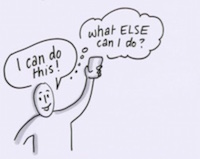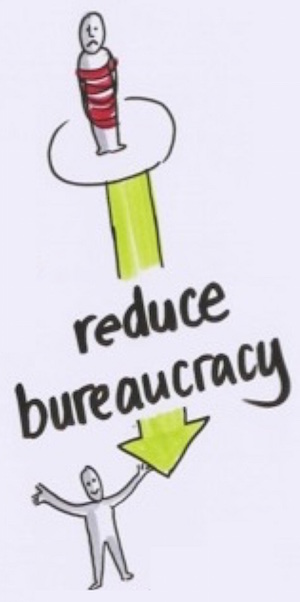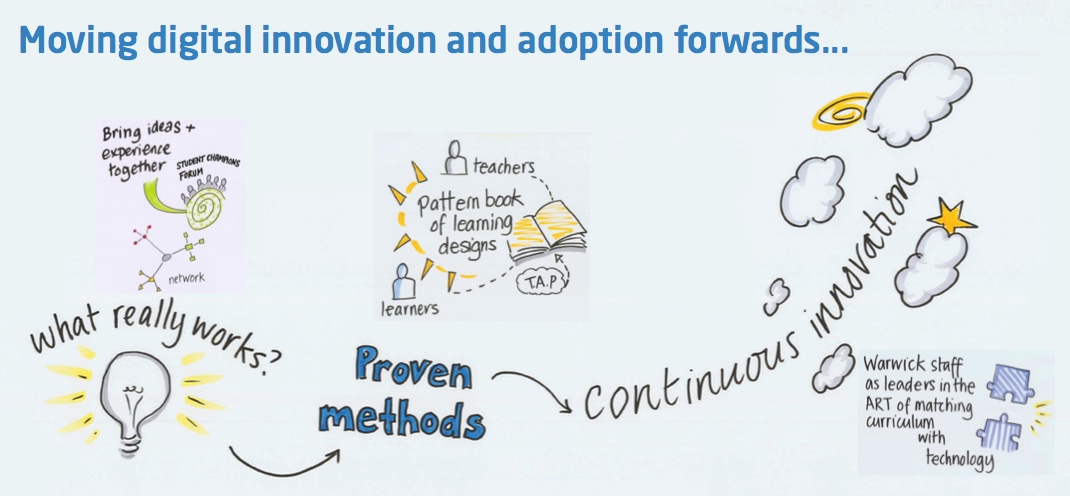Competency framework summary
What are we aiming for?
We want to see enduring improvements in what teachers do, what academic and service departments provide, and how students participate in LTSE. The framework identifies three equally important categories of enhancement:
- Achieve appropriate flexibility for students and staff.
- Ensure coherence, quality and fairness for students and staff.
- Enable opportunities for pedagogic innovation and new signature pedagogies.
Student participation is essential to each of these. We need to design and adopt new practices that work for students and staff together, optimising their opportunities and efforts. Technology plays an important part in this. But it needs to be wrapped in well designed LTSE practice - best possible practice. We need Student Champions, competent participants in the LTSE enhancement process, to complement our teaching champions and our excellent services.
Roles that students can play in the enhancement of LTSE
Enhancement activities should not occur in isolation. Staff and students can amplify their capability for effective design change by working together, learning from each other, and cooperating through a common platform of technologies, services and spaces - collectively shaping its development. The competency framework sees Student Champions and teachers (Teaching Champions) as sophisticated change agents working together in an institution-wide "learning and design loop". The three key outputs should be:
- A growing repertoire of LTSE practices - well designed, robust, widely understood (including by students), trusted, adopted as widely as possible, and adapted appropriately to meet diverse needs.
- Sustainable platforms, spaces and services used to their full potential and continually improved through feedback channels from students and staff.
- A deep and wide network of capable staff and students, extending beyond the University, with well developed skills and knowledge developed from real practice, applicable to the design and development of technology and learning systems, content and activities - in and beyond education.

In addition, the Student Champions should help us to reduce the administrative burden of LTSE enhancement work - not by taking over admin work, but by helping us all to work smarter. In the co-design workshop, the student made it clear that they want to see a decrease in bureaucracy, not an increase.

The framework is based upon a simplified model that describes how this is achieved by groups of people (e.g. a module team or a programme team) through repeated learning and innovation loops. They go from recognising the nature and value of new practices (reflecting on current practice, needs and ambitions), building sufficient understanding of new practices, adopting-adapting, continuing-reflecting, becoming informed advocates for the practice and feeding back into the design and development process through which platforms (tools, technologies, services) are refined and extended.
The loop was visually represented in the co-design workshop:

By bringing lots of people through this loop on many different individual projects, and most importantly networking them together (with the aid of the Student Champions) we develop a culture and a capability for coherent continuous innovation.

On to this, the framework maps nine essential roles. A single Student Champion might perform all of these roles on their own, or in combination with other students and staff members. They should also transfer some of their capability to staff collaborators - especially capabilities that enable the use of new technologies, informed advocacy (being able to communicate the value of a practice) and design participation (feeding back to its development). One of the key strategic aims of this approach is to develop a much wider pool of competent informed advocates and design participants - including staff and students.

The nine roles are:
- Informed advocate - able to communicate the nature and value of a LTSE practice, essential in helping people to recognise the nature and value of enhanced practices.
- Technical facilitator - competent in helping with spaces, learning designs, technologies etc, facilitation roles help build sufficient understanding (for example by helping people to try out enhanced practices), and then they smooth the way to adoption/adaptation.
- Social facilitator - organising and supporting people, through digital and face-to-face channels.
- Admin process facilitator - data, processes, bureaucracy etc.
- Project facilitator - forming, managing, embedding, showcasing projects.
- Critical-creative friend - does it work? how might it be different? how might it be extended? improved? Trusted students who can help us to think and create.
- Researcher - applying academic methods to analyse behaviour and processes, make tacit knowledge explicit, build and test theories, to search for relevant research or alternative approaches.
- Horizon watcher and visionary - dreaming the impossible so as to start making it possible.
- Design participant - bring all that context specific knowledge and experience back into the design of our platforms, essential in ensuring that service providers and technology developers do the right things in the right way at the right time.
Competencies required for the nine roles
The full Competency Framework report examines each of these roles in depth, considering what it takes to be demonstrably "competent".
Designing and implementing a Student Champion scheme
Based upon the competency framework, with the ambition of embedding it within a cohesive institution-wide enhancement process, we are developing a proposal for a scheme at Warwick.
Glossary
LTSE - learning, teaching and the student experience.
Signature pedagogy - an approach to teaching that has emerged from within an academic discipline as an adaptation of disciplinary practices, student needs and capabilities, and generic teaching methods and facilities.
Platform - a coherent and managed system of spaces, datastores, processes etc. upon which we construct our LTSE activities; a blended-learning or extended classroom platform combines physical and digital spaces and technologies.
